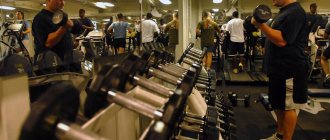What should your heart rate be on a treadmill for fat burning and other purposes – 5 heart rate zones
In modern cardio training on aerobic machines, much attention is paid to dividing the achieved heart rate (heart rate) into pulse zones.
Why is it so important to know your pulse? And what should it be like when walking and what when running? The specific effect achieved by the exercises depends on its frequency (development of the cardiac, vascular and respiratory systems, weight loss, increased endurance, strengthening of the muscles of the lower extremities).
The basic principle is that during training the emphasis is on achieving and maintaining a certain number of heartbeats in the desired zone to obtain the intended effect. A training structured in this way will be more effective and will allow you to achieve your goal in a shorter time, constantly monitoring the intensity of the load.
How to calculate your maximum heart rate (MHR)?
This indicator is a theoretical conditional value.
This is the simplest and most popular formula that can be used in load calculations. It must be remembered that this will be exactly the maximum indicator that is observed during intense exercise.
The normal resting heart rate of a healthy adult is up to eighty beats per minute. And, for example, in the morning when waking up, it may have lower values - on average seventy beats per minute.
It will become even clearer after watching the video:
Dangerous heart rate when running
The heart rate for safe cardio is 115-150 beats per minute - going to higher numbers is allowed, but for one or two minutes (as in the case of fat-burning HIIT workouts).
Being in the zone of 90-95% of maximum heart rate is dangerous. If you reach these numbers, take a break. Also note that at the age of 30, the normal resting heart rate is 60-80 beats per minute - if your heart rate is above this value, then you most likely have elevated levels of the hormone cortisol. Let us remember that this hormone is responsible for the gain of fat in the abdominal area.
How to get rid of fat in the lower abdomen and remove soft sides? The best training strategy and cutting recommendations.
Why measure your heart rate when training for weight loss?
It is necessary to build your workouts based on your heart rate in order to quickly achieve your goal.
It is recommended to correctly determine your zones in which this indicator will be maximum, effective and safe. The training must be tailored specifically to your individual characteristics - gender, age, weight, health status, level of physical development and correlate these indicators with the purpose of training.
Therefore, it is better to calculate the coefficient for each individual person.
Peculiarity! For weight loss, the principle “the higher the heart rate, the more benefits I will get” does not work.
What should your heart rate be to burn fat?
The most optimal zones for burning fat are the second and third, which we discussed above. There are loads here that provide an average heart rate of seventy-five percent. This is a normal heart rate when running. It is when working in this range that the most intense fat burning is ensured. In addition, you definitely need to know how much time you need to run on the machine, based on your goals.
Attention! Sports instructors recommend running on a treadmill for an hour to burn fat deposits. It is performed at a calm pace while maintaining an individual heart rate.
At what heart rate does fat burn faster?
Heart rate is the main parameter that influences the number of calories burned during physical activity.
If fast walking can accelerate the heart of an untrained person to high speed, then a professional marathon runner can run with a low heart rate. Separately, we note that training at a higher heart rate puts excessive stress on the body and leads to health problems. This is why it is important to monitor your heart rate while running. Untrained people will easily go beyond the limits of fat burning, going into the danger zone.
How to measure it?
- Place your middle and index fingers together on the inside of your wrist. Feel the pulse area. Start the stopwatch and count the number of beats for one minute. The resting pulse in women is seventy to eighty beats per minute. For men, this figure is about sixty seventy beats per minute.
- A simpler way that you can use is to count the number of heartbeats using a heart rate monitor, which can be easily purchased at any sports equipment store.
- Many modern types of treadmills are equipped with built-in cardiac sensors (small metal plates, usually located on the handles of the machine; to read the indicators, you need to hold both palms on the sensors). Contact sensors measure heart rate automatically and display the results on the electronic display of the simulator. This is very convenient, since visual control does not take up much attention, and this allows you to concentrate on achieving and maintaining results during class. Exercise machines also allow you to keep track of calories burned.
Workout load and heart rate are inextricably linked. By knowing your individual maximum heart rate in each zone, you can tailor your workouts to your goals and physical characteristics and train in a targeted and effective manner. The greatest effect can be achieved by alternating load levels.
It must be remembered that increasing the intensity of the load is not justified in all cases and is selected individually. Train on the treadmill regularly and in an individually selected zone, and you will ensure good health and a fit, athletic appearance!
Normal human heart rate
A percentage of your maximum heart rate (MHR) is used to estimate your heart rate during running and other sports. It, in turn, is determined by the formula “220 minus age in years.” For example, the maximum safe heart rate for a 30-year-old is 190 beats per minute.
- Resting pulse - 35-40% MPP (60-80 beats for 30 years)
- Warm-up zone - 50-60% MPP (95-115 beats)
- Activity zone - 60-70% MPP (115-135 beats)
- Aerobic zone - 70-80% MPP (135-150 beats)
- Endurance zone - 80-90% MPP (150-170 hits)
- Danger zone - 90-95% MPP (170-180 blows)
It is not necessary to remember all the above numbers; the main thing is to remember your maximum heart rate and try not to leave the safe aerobic zone. You can measure your heart rate when training on most exercise machines using built-in sensors; when running, using chest-mounted heart rate monitors.
Is it normal for a heart rate of 160-180 on a treadmill?
Hello, I'm 20 years old, female. My heart speeds up quickly during physical activity. Usually, at rest, my heart rate is about 80 beats per minute during the day, but as soon as I give my body a load, it quickly begins to increase.
The heart rate on the treadmill from 150 very quickly rises to 160-180 beats per minute, I alternate running and walking, I can’t just run. I can’t run on a treadmill or swim for a long time, my heart “jumps out of my chest,” it shrinks inside me and my heart rate immediately rises to 190 beats or higher from long workouts. I once went to the doctor (two years ago) and they said it would go away, a la age-related, but I think it’s nothing like that. Is it worth paying attention to this? This condition has been like this for quite some time, about 6 years to be exact.
Moderately active lifestyle. Cycling, swimming, trying to accustom myself to long running (due to my condition I can’t).
I don’t have an ECG in my hands, but recently I checked my heart rate was about 100-110, I think it accelerated by the time I got there and lay down, at rest at home my heart rate is still around 80.
I don't see any particular reason for concern. This is a normal situation for young girls. Exercise in moderation without overloading your heart.
Please read our materials on the topic of calculating physical activity by heart rate:
- Calculating heart rate for fat burning - the article contains both formulas for independent calculations and a simple online calculator that will quickly help you determine the desired heart rate zone for effective weight loss during training.
- Pulse zones - a detailed description of all 5 pulse zones, with examples of calculations to determine the most accurate, individual and safe cardio training zone.
- Normal heart rate for running - what heart rate a person should have when jogging, short and long distances.
How does heart rate affect fat burning?
The pulse is the push of blood into the walls of the arteries, which is caused by the heart muscle. The unit of measurement is the heart rate or heart rate. The usual normal heart rate ranges from 60 to 100 beats per minute. For athletes, the range can be significantly lower - from 40 to 60. The frequency increases with increasing load. Along with an increase in load, the volume of carbohydrates burned increases, and accordingly, the level of fat burning also increases. At the same time, even with the goal of maximum fat burning, you should not exceed the maximum load limit, which is also called maximum heart rate. Further in the article we will tell you at what heart rate fat is burned and how to calculate your own optimal indicators.
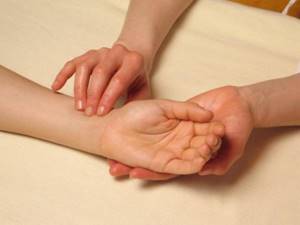
The pulse is the push of blood into the walls of the arteries
At what heart rate does fat burning begin?
At what heart rate does fat burn in men and women? The best indicator occurs in the period from rest to the state of maximum value. That is why, if you want to lose weight, you must strive to perform exercises that will increase your heart rate to the zone of maximum calorie burning. Typically, a range of 75 to 85 percent of the maximum value is recommended. Such results are achieved by fast and energetic movements. However, this pace is suitable for a trained person, and for those who are not in the best shape, the load should begin with some preparation.
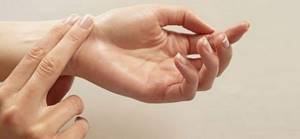
At what heart rate does fat burn, myths and reality?
From this article you will learn how important it is to maintain a certain heart rate during exercise to burn fat, how to calculate the desired heart rate, and with what exercises you can reduce the amount of fat tissue in the body. Heart rate limits for improving fat burning - is it true or a myth?
The content of the article:
Many people who want to get rid of excess fat tissue and lose weight have heard about the heart rate range for burning fat. It is believed that fat will be burned best during physical activity during which the heart rate is 60-75% of the maximum age-related heart rate.
This statement is quite controversial - which we will discuss later in the article. The main condition for successful weight loss is that a person must spend more calories than they consume in food.
What is the maximum age-related heart rate?
Physical activity causes a person's heart to beat at different rates, which depend on the intensity of the activity. Therefore, many people use heart rate to determine the required intensity of exercise.
The maximum age-specific heart rate is the number obtained by subtracting the person's age in years from 220. This formula was obtained empirically from young athletes. Examples of calculations:
- A person aged 50 years: maximum heart rate = 220 – 50 = 170.
- A person aged 35 years: maximum heart rate = 220 – 35 = 185.
The influence of heart rate on the effectiveness of training
In reality, maximum heart rate tolerance is individual for each person. For professional athletes, this indicator is specifically determined experimentally.
What heart rate is needed for maximum fat burning?
There is a theory that at a certain intensity of exercise, fats are burned better. This intensity is monitored by heart rate. Many people argue that fats in the body break down faster at a load where the heart rate is 50-70% of the maximum age-related heart rate.
Example calculations for a person aged 50 years:
- Maximum heart rate – 170 beats. / min.
- The lower limit of the heart rate range for fat burning: 0.5 x 170 = 85 beats. / min.
- Upper limit of the heart rate range for fat burning: 0.7 x 170 = 119 beats. / min.
On topic: Running to lose weight in your legs
According to this theory, to burn fat faster, a 50-year-old person needs to exercise at such an intensity that his heart rate is between 85 and 119 beats. / min. According to supporters of this theory, it is at this intensity of physical activity that the body uses fats to a greater extent as an energy source.
The Heart Rate Theory for Fat Burning: Myth or Reality?
This theory gained popularity along with the appearance of color graphs on the consoles of treadmills and exercise bikes, indicating at what heart rate the best fat burning.
Its proponents argue that it is through long-term physical activity of moderate intensity, maintaining the pulse at 50-70% of the maximum heart rate, that it is best to burn fat in the body. With more intense exercise, carbohydrates, rather than fats, become energy sources.
Based on this theory, long-term, low-intensity exercise is best suited for reducing the amount of fatty tissue in the body.
As with any hypothesis, there is both truth and error in this statement. The number of calories burned is directly related to the intensity of physical activity.
Indeed, the body uses fats as its main source of energy during moderate-intensity exercise. It was this fact that became the source of the theory about at what heart rate fat is burned faster.
Attention!
At low intensity, a person needs to exercise longer to burn a large number of calories.
But what matters more is the total number of calories burned, regardless of their source. A person performing heavy exercise burns more fat per unit of time than during moderate physical activity.
For example, in 30 minutes at 65% of your maximum heart rate, 150 calories are burned, of which 50% (75 calories) are from fat. When the intensity is increased to 85% of the maximum heart rate, 210 calories are burned, of which 40.5% (85 calories) are from fat.
When a person performs light exercise, his body spends a small amount of energy after finishing it. After intense exercise, calories are burned, the severity of which depends on the type of exercise and its severity.
Scientists conducted a study that examined calorie loss during low- and high-intensity exercise lasting 3.5 minutes and 45 seconds, respectively.
Participants in the light exercise group burned 29 calories in 3.5 minutes, and those in the heavy exercise group burned 4 calories in 15 seconds.
But when the calories burned after exercise were calculated, the numbers were completely different - 39 calories in the low-intensity exercise group and 65 calories in the high-intensity exercise group.
Another study showed that a significant amount of fat from fat stores in muscles is burned after intense exercise. Thus, the human body, even burning mainly carbohydrates during intense exercise, continues to break down fat after its completion.
Optimal heart rate range for men and women
What is the optimal heart rate value? For each person it is individual and depends on the state of health and fitness of the body. Let's consider different options:
- moderate loads and the same heart rate of 50 percent of the maximum heart rate are sufficient at the initial stage - this can be a simple fast walk or a slow jog. This zone is suitable for general strengthening of the body, lowering cholesterol levels in the blood and blood pressure, but it will not help you lose weight;
- the load can be increased to 60-70 percent - this is the support zone, which includes light jogging. They require some calories, which means they burn some fat. With relatively moderate loads, you can run for quite a long time and not very intensely until the desired result is achieved, but the weight will be under control;
- The aerobic zone begins at a heart rate of 70-80 percent of maximum. This is a zone of intense running that increases the overall endurance of the body with an increase in lung capacity, strengthening of the heart muscle, achieving a longer workout duration with a feeling of less fatigue. This means that the person has already entered the zone where he can lose weight and stay in good shape;
- the anaerobic zone - the pulse here increases to 80 percent and above. This is a fast run, very tiring and short. It is tiring because the heartbeat is quite frequent, but the heart does not always have time to supply the muscles with oxygen, and it does not last long because it is impossible to exercise in this mode for a long time. However, even after training, muscles continue to burn calories and therefore this range is excellent for fat burning;
- a heart rate value of 90-100 percent of the maximum is already a red interval, when the fat issue no longer comes to the fore, since this is a zone of sports and athletic loads and the body works at the limit of its capabilities, the loads are incredibly high, but short-term.
So, it is the heart rate that affects the result of fat burning. Fat and calories are burned at certain and high levels, which is why people who exercise or take long walks may not lose weight at all. After all, only a cardio training regime that uses a pulse calculator allows you to actually burn calories and excess fat accumulation. It is very important to determine the optimal loads based on your condition, preparation and capabilities.
Formula for calculating heart rate for a treadmill
Why do you need to calculate your pulse, because the higher it is, the faster the destruction of fat accumulation occurs. This is true, however, accelerating the heart rate will inevitably lead to fatigue setting in just as quickly, and then it will not be possible to reach the required training duration. Meanwhile, to launch the fat destruction mechanism, you need to spend at least forty minutes of intense exercise.
How to correctly calculate your heart rate when running for maximum fat burning
So, a resting state is characterized by a pulse of 70-80 beats in 60 seconds (if a woman) and 60-70 (a man). A person may have such a pulse in bed if he has not yet gotten up. The older a person is, the higher his pulse becomes. And here are the heart rate values at which weight loss can begin.
Theoretically, the maximum heart rate can be detected at maximum loads, but in real conditions few people reach this level of load. It’s easier to find out the value of this pulse theoretically; there is a formula for this, it is quite accurate. This formula is used in fitness and is named after its discoverer, Karvonen. Its calculation is as follows: you need to subtract age from 220. However, the application of this formula by everyone would mean that for all 40-year-old women, as well as 40-year-old men, the maximum heart rate should be the same and be 180 beats per minute. That's why there are more complex formulas for calculating heart rate for weight loss.
What should your heart rate be to burn fat?

Professional athletes have long known that in order to burn fat during cardio training, it is very important to correctly calculate your heart rate, then energy consumption will increase as much as possible and fat burning will be much more effective.
How to calculate your heart rate and choose the optimal load to help you lose weight during cardio exercises such as running on a treadmill, exercising on an exercise bike, on an elliptical or while walking?
This article will help you accurately calculate the optimal heart rate that is effective during cardio for weight loss.
How to properly run to lose weight?
Running to burn fat is the first step in most weight loss workouts.
However, running can be dangerous for overweight people (most often they have weak knee joints, and the running technique itself suffers), but it is not always the most effective way to quickly burn fat. Research suggests that the best cardio for weight loss is either long, moderate exercise (such as slow running) performed in the fat-burning heart rate zone, or high-intensity interval training (HIIT) performed on special exercise bikes.
What should your heart rate be during cardio to burn fat?
You can calculate your heart rate during cardio training to burn fat yourself. However, first you need to properly structure your workout in such a way that strength and cardio exercise is guaranteed to lead to weight loss.
Professional athletes know that during cardio exercise, the heart rate increases and the pulse increases, providing a fat-burning effect. However, to achieve optimal results, it is necessary to maintain the heart rate in a certain zone, without lowering or increasing it.
Experts are unanimous that the best way to lose weight is to choose moderate and fairly long-lasting exercise, which is performed in the fat-burning zone of our heart rate.
This could be running on a treadmill at medium speed, brisk walking, or riding an exercise bike or elliptical. The main thing is that during exercise your heart rate stays in the same zone.
Why you need to monitor your heart rate during training:
- Thanks to the heart rate per minute indicator, you can determine whether such a load is suitable for you. If the training is not intense enough, you will not be able to achieve the desired effect and lose weight. If you exceed the permissible limit and push yourself too hard in the gym, then you will only be able to harm your own health.
- Focusing on your pulse is much easier and more correct than focusing on your own well-being when doing cardio training for fat burning. When running on a treadmill or stadium, many people give up after the first kilometer, believing that they will not be able to continue their cardio due to shortness of breath or extreme fatigue. In fact, at this moment their heart rate in the fat-burning zone reaches its optimal value, ideal for losing weight. To achieve the desired effect, you must overcome yourself and continue training.
- With regular monitoring of your heart rate during cardio, you can always train in the fat-burning zone, thereby creating excellent conditions for sustainable weight loss.
- By monitoring your heart rate during cardio, you can correctly calculate your calorie expenditure.
- People who have some heart problems should definitely count their heart rate.
Formula for calculating heart rate for burning fat
What should be the heart rate for fat burning and how to calculate the heart rate for fat burning yourself? This will not be difficult to do if you know the special formula. However, first you should find out what heart rate indicators are normal for a person.
Let's look at the average values for a person under 35 years of age:
- In a calm state - from 60 to 80 beats per minute (35-40%).
- When warming up - from 95 to 115 beats per minute (50-60%).
- In the activity zone - from 115 to 135 beats per minute (60-70%).
- In the aerobic zone - from 135 to 150 beats per minute (70-80%).
- In the endurance zone - from 150 to 170 beats per minute (80-90%).
- Danger zone – from 170 beats per minute (90-95%).
The most important thing in every aerobic workout for fat loss is to avoid getting into the danger zone, when the body begins to work “for wear.”
As for the formula for determining the optimal heart rate during cardio training, it is quite simple: you need to subtract your age from your maximum heart rate, then multiply the resulting figure by the minimum and maximum percentage . This formula has long been adopted by many fitness trainers.
Formula for calculating heart rate for burning fat:
220 - age = A
Lower limit: B = A x 0.65
Upper limit: C = A x 0.85
Many nutritionists believe that only long-term training with minimal stress leads to intense fat breakdown.
An ideal example of such a fat-burning workout: running on a treadmill at a moderate pace (the duration should be at least 40 minutes), as well as interval running, in which you alternate between running at a maximum and a low speed.
Effective Heart Rate Zone
The effective heart rate zone for burning fat is the optimal heart rate for burning calories, and staying in such a zone during cardio training ensures that you get the desired result - stable weight loss.
The fat-burning zone for weight loss during cardio for a person aged about 30 years is considered to be from 115 to 130 beats per minute. It is by working at this pace that our body is able to burn the maximum amount of calories (and therefore fat) during the workout.
In this rhythm, you can work in the gym for quite a long time, thereby ensuring maximum fat burning. If you believe scientific data, then in half an hour of exercise in such a zone you can burn about 150 calories, of which 75 calories are fat itself.
If you work at a lower intensity, fat burning will occur more slowly. With increased load, the body will be exhausted in a short time, and the desired effect for losing weight will not be achieved.
Running heart rate
Many people are interested in what their heart rate should be when running to burn fat. To ensure maximum fat burning when running, you need to remember that the total duration of such a workout is more important, and not its intensity.
In other words, it is better to run for half an hour at an average or slow pace than to run for 15 minutes at maximum acceleration. With the first option of running, more calories will be burned, and accordingly, the fat burning result will also be achieved faster.
Pulse for weight loss and fat burning
The fat-burning heart rate zone is 60-70% of the MHR (115-130 beats for the age of 30 years) - training at this heart rate forces the body to cover the maximum number of calories from fat.
The fact that training in this zone can be quite long also plays a role. Scientific evidence suggests that in 30 minutes of training, approximately 146 calories are burned in the fat-burning zone, 73 calories (50%) of which are fat. When training at a higher or lower heart rate, the body works differently, covering no more than 35-40% of energy costs from fat.
When walking on a treadmill, what should your heart rate be?
Treadmill
- a popular and convenient solution in our area for those who decided to improve their fitness with the help of the most ancient sports discipline. In our nine-month winter, when most of the year the temperature outside is not suitable for running, a path in a heated room really looks much more attractive. If you're serious, you can expect to save money on gym memberships - after some time, the purchase will fully pay for itself. Another advantage of the treadmill is that it is quite possible to exercise effectively on your own, without the help of a trainer. You just need to know a few simple principles and rules.
Let's start with basic safety precautions.
. Many beginners get injured due to inexperience. First, get comfortable clothes and shoes. Don’t even think about running barefoot, especially if you don’t have any training yet, you’re almost guaranteed to hurt yourself. It is better to wear comfortable sneakers or sneakers that fit well on your feet.
Do not forget
about the stop key, most modern tracks have this function. A small magnet that attaches to the “Turn Off” button and to your clothing. Its job is to turn off the track if you get too close to the edge. Beginners often do not calculate their strength or simply “get lost” without feeling the edge behind them, so such a stop key will protect you from falls.
If you choose to watch
some movie or news while you are running, then this also needs to be done correctly. The TV or computer screen should hang directly in front of you, a little higher. But you shouldn't turn your head and get distracted. In general, at first you will not be able to focus on anything other than running. Unless you can listen to music.
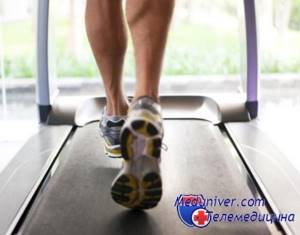
So, the stop key is connected
, you dressed in comfortable clothes, did warm-up exercises, stretched your joints and ligaments, put your feet on special rubber supports along the edges of the treadmill, and turned it on. What's next? Run it for ten to fifteen seconds in idle mode, this will protect the simulator engine from sudden loads. Now get up on it and walk. Any running activity begins with a minute of walking.
If you are a beginner, you will most likely not be able to complete the 5K distance. right away
. This is the average distance that can provide you with good aerobic exercise. But, you must admit, not every modern city dweller is able to cover 5 kilometers on foot, let alone running. So you will need to choose a program that will first get your muscles in shape, train your lungs, and improve your body. Working with beginner programs, of which there are a huge number posted online, you will find that during the first week of training you will walk more than run. But despair: in just one and a half to two months, you will easily run the mentioned 5 km, and then your training will become even more effective. The main thing here is patience.
On average, the training duration should be from half an hour to an hour.
. This is exactly the time our body needs during running so that it uses up its glycogen reserves and begins to use the stored fat. But, as already mentioned, in order to cover such distances, you will need to practice a little first.
Recommended training frequency: 3 times a week
. If you do it less often, it won't do any good. But it is not recommended for a beginner to run too often; first you need to train your muscles. You shouldn’t discourage yourself from working further with excessive fatigue from a sudden start. In everything and always moderation is important.
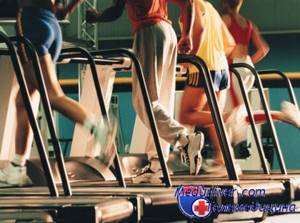
It is also important to monitor your own heart rate while running.
. If the simulator itself is not equipped with a special heart rate monitor, it can be purchased separately, it is not expensive. The range of your heart rate in which you need to run is calculated using a simple formula: - subtract your own age from 220, multiply the resulting difference by 0.6 = we get the lower value of the heart rate range; — 220 — your age * 0.8 = we get the upper value of the heart rate range when running.
In this simple way you get the lower and upper range
. You must be careful not to go beyond it. Otherwise, your workout will be either useless or dangerous to your health.
Running is so loved by many because it is guaranteed.
a way to lose weight, with the right approach, in contrast to all sorts of tablets and tinctures, decoctions and other potions, as well as strange exercise equipment, which are often extremely ineffective. The treadmill has long proven itself as a means of losing extra pounds. Another thing is that not everyone has the willpower to bring a good undertaking to a victorious end, but this is a completely different question.
Don’t forget about the rejuvenating effect
running on the body. Running not only improves metabolism and helps eliminate toxins from the body, but also saturates our body with oxygen. This is why, by the way, the room where you jog should always be clean of dust and well ventilated so that the body is saturated with only fresh air.
Well, and finally, it remains to add a few words about the wonderful effects of running
on our well-being. Running entails a fairly powerful release of hormones that improve our well-being and bring a feeling of calm joy. All that stands between you and all these benefits is laziness and a trip to the sporting goods store.

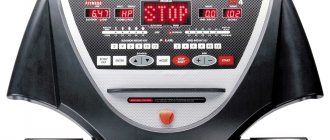




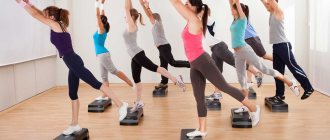
![Cardio training for burning fat at home [video selection]](https://activel.ru/wp-content/uploads/kardio-trening-dlya-szhiganiya-zhira-doma-video-podborka-330x140.jpg)
